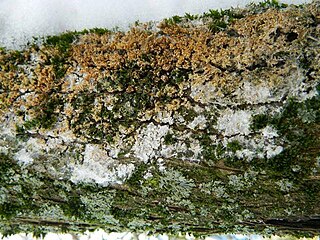
Celery is a marshland plant in the family Apiaceae that has been cultivated as a vegetable since antiquity. Celery has a long fibrous stalk tapering into leaves. Depending on location and cultivar, either its stalks, leaves or hypocotyl are eaten and used in cooking. Celery seed is also used as a spice and its extracts have been used in herbal medicine.

The parsnip is a root vegetable closely related to carrot and parsley, all belonging to the flowering plant family Apiaceae. It is a biennial plant usually grown as an annual. Its long, tap root has cream-colored skin and flesh, and, left in the ground to mature, it becomes sweeter in flavor after winter frosts. In its first growing season, the plant has a rosette of pinnate, mid-green leaves. If unharvested, in its second growing season it produces a flowering stem topped by an umbel of small yellow flowers, later producing pale brown, flat, winged seeds. By this time, the stem has become woody and the tap root inedible.
Sequivirus is a genus of viruses in the order Picornavirales, in the family Secoviridae. Plants serve as natural hosts. There are currently three species in this genus including the type species Parsnip yellow fleck virus. Diseases associated with this genus include: PYFV: vein-yellowing, yellow flecks and yellow/green mosaic symptoms in parsnip, and ‘yellow net', followed by yellow spots and leaf distortion in celery.

Potyvirus is a genus of viruses in the family Potyviridae. Plants serve as natural hosts. There are currently 183 species in this genus including the type species Potato virus Y. The genus is named after the type virus. Potyviruses account for ~30% of the currently known plant viruses. Like begomoviruses, members of this genus may cause significant losses in agricultural, pastoral, horticultural and ornamental crops. More than 200 species of aphids spread potyviruses and most are from the subfamily Aphidinae.
Tenuivirus is a plant virus genus belonging to Phenuiviridae family in the order Bunyavirales, of which the type member is Rice stripe tenuivirus. These plant viruses cause diseases in their host plants. Typical symptoms are chlorotic stripes on the affected leaves. This group of viruses also make viral inclusions in infected cells which can be used to diagnose infection.

Closterovirus, also known as beet yellows viral group, is a genus of viruses, in the family Closteroviridae. Plants serve as natural hosts. There are currently 16 species in this genus. Diseases associated with this genus include: yellowing and necrosis, particularly affecting the phloem. This genus has a probably worldwide distribution and includes among other viral species the Beet yellows virus and Citrus tristeza virus, rather economically important plant diseases. At least some species require vectors such as aphids or mealybugs for their transmission from plant to plant.

The carrot is a root vegetable, usually orange in color, though purple, black, red, white, and yellow cultivars exist. They are a domesticated form of the wild carrot, Daucus carota, native to Europe and Southwestern Asia. The plant probably originated in Persia and was originally cultivated for its leaves and seeds. The most commonly eaten part of the plant is the taproot, although the stems and leaves are also eaten. The domestic carrot has been selectively bred for its greatly enlarged, more palatable, less woody-textured taproot.

Aster yellows is a chronic, systemic plant disease caused by several bacterium-like organisms called phytoplasma. The aster yellows phytoplasma (AYP) affects 300 species in 38 families of broad-leaf herbaceous plants, primarily in the aster family, as well as important cereal crops such as wheat and barley. Symptoms are variable and can include phyllody, virescence, chlorosis, stunting, and sterility of flowers. The aster leafhopper vector, Macrosteles quadrilineatus, moves the aster yellows phytoplasma from plant to plant. Its economic burden is primarily felt in the carrot crop industry, as well as the nursery industry. No cure is known for plants infected with aster yellows. Infected plants should be removed immediately to limit the continued spread of the phytoplasma to other susceptible plants. However, in agricultural settings such as carrot fields, some application of chemical insecticides has proven to minimize the rate of infection by killing the vector.

Partitiviridae is a family of double-stranded RNA viruses. Fungi and plants serve as natural hosts. The name comes from the Latin partitius, which means divided, and refers to the segmented genome of partitiviruses. There are 60 species in the family which are divided into five genera or unassigned to a genus.

Athelia arachnoidea is a corticioid fungus in the family Atheliaceae. The species forms thin, white, cobwebby basidiocarps and typically occurs saprotrophically on leaf litter and fallen wood. It can, however, also be a facultative parasite of lichens and can additionally be a plant pathogen, causing "crater rot" of stored carrots.
Carrot mottle virus (CMoV) is a plant pathogenic virus.
Carrot red leaf virus (CtRLV) is a plant pathogenic virus of the family Luteoviridae.

Lontong is an Indonesian dish made of compressed rice cake in the form of a cylinder wrapped inside a banana leaf, commonly found in Indonesia, Malaysia and Singapore. Rice is rolled inside a banana leaf and boiled, then cut into small cakes as a staple food replacement of steamed rice. The texture is similar to those of ketupat, with the difference being that the ketupat container is made from woven janur fronds, while lontong uses banana leaf instead.

Secoviridae is a family of viruses in the order Picornavirales. Plants serve as natural hosts. There are currently 86 species in this family, divided among 8 genera or not assigned to a genus. The family was created in 2009 with the grouping of families Sequiviridae, now dissolved, and Comoviridae, now subfamily Comovirinae, along with the then unassigned genera Cheravirus, Sadwavirus, and Torradovirus.

Arem-arem is a Javanese snack made of rice, vegetables fillings, eaten as a snack.
Polerovirus is a genus of viruses, in the family Luteoviridae. Plants serve as natural hosts. There are currently 26 species in this genus including the type species Potato leafroll virus. Diseases associated with this genus include: PLRV causes prominent rolling of the leaves of potato and a stiff upright habit of the plants; necrosis of the phloem and accumulation of carbohydrates in the leaves.
Torradovirus is a genus of viruses in the order Picornavirales, in the family Secoviridae. Plants serve as natural hosts. There are currently six species in this genus including the type species Tomato torrado virus. Diseases associated with this genus include: torrado disease: severe necrosis of leaves and fruits.
Carrot virus Y (CarVY) is a (+)ss-RNA virus that affects crops of the carrot family (Apiaceae), such as carrots, anise, chervil, coriander, cumin, dill and parsnip. Carrots are the only known crop to be infected in the field. Infection by the virus leads to deformed roots and discolored or mottled leaves. The virus is spread through insect vectors, and is currently only found in Australia.










